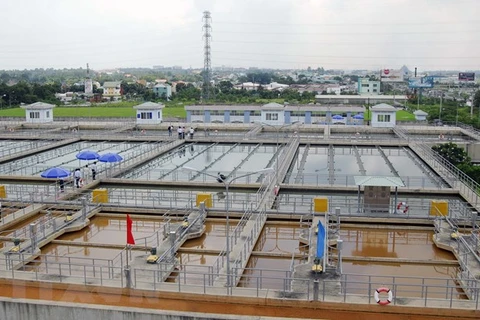 International experts share experience in water supply system management and solutions for HCM City.
International experts share experience in water supply system management and solutions for HCM City.(Photo: VNA)
HCM City (VNS/VNA) – Ho Chi Minh City needs a master plan for 30 years to make sure that investments in water supply dovetail with the overall long-term plan, experts have said.
The master plan should give directions and guidance and be implemented with flexibility, said Sytze Jarigsma, former resident project manager of the Utility Support Programme funded by the Dutch embassy.
The plans allows application of new technology if available and welcomes improvements based on newer insights, he told a conference last week on international and domestic experience in research and application for water supply recommendations for HCM City for the 2019-2035 period.
Raw water development needs urgent consideration, he said.
Currently, there are three water sources for the city, the Dong Nai and Sai Gon rivers and groundwater, he said.
The Dong Nai river is a good source for probably another 10 years or so, but after that climate change is expected to affect salinity too much, he said.
The Sai Gon river is already a good source that has been affected by high salinity and pollution, he said.
Groundwater abstractions would be phased out soon to limit ground subsidence, he predicted.
Raw water intakes at existing upstream Dau Tieng and Tri An lakes would be options for the city, he said.
It would be an achievement if non-revenue water or water losses could be brought down to 20 percent, and not much more could be expected, he said.
In the long term, new pipes would be installed and bad ones would be removed, resulting in reduction in water losses, he said.
Paul Smith of the Australian Water Association (AWA) said the greatest risks to consumers of drinking water are pathogenic micro-organisms.
Protection of water sources and treatment are of paramount importance and cheaper than treatment, he said.
A drinking water system must have and continuously maintain robust multiple barriers commensurate with the level of potential contamination, he said.
Vo Van Hoan, Vice Chairman of the HCM City People’s Committee, said rapid urbanisation has put pressure on the city’s water infrastructure, which is ageing.
It is a great challenge for the city to maintain water supply and keep pace with the economic growth, he said.
It has made huge efforts to accomplish the target of supplying clean water to 100 percent of households, he said.
But the city is in the downstream area of the Dong Nai river and Sai Gon river, and is affected by what happens upstream, he said.
Climate change and pollution have worsened water supply, he said. “The city is urgently developing a project for drinking water supply.”
It brought down water losses to 23.3 percent from 26 percent in 2017 and 30.9 percent in 2015. Its daily water supply total capacity is 2.4 million cubic metres.
According to the Department of Construction, the city will upgrade 1,430km of old pipelines and install more new pipelines by 2025./.























